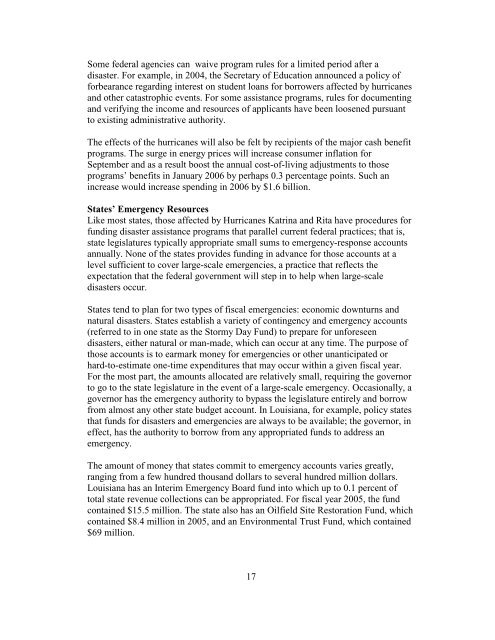Macroeconomic and Budgetary Effects of Hurricanes Katrina and Rita
Macroeconomic and Budgetary Effects of Hurricanes Katrina and Rita
Macroeconomic and Budgetary Effects of Hurricanes Katrina and Rita
You also want an ePaper? Increase the reach of your titles
YUMPU automatically turns print PDFs into web optimized ePapers that Google loves.
Some federal agencies can waive program rules for a limited period after a<br />
disaster. For example, in 2004, the Secretary <strong>of</strong> Education announced a policy <strong>of</strong><br />
forbearance regarding interest on student loans for borrowers affected by hurricanes<br />
<strong>and</strong> other catastrophic events. For some assistance programs, rules for documenting<br />
<strong>and</strong> verifying the income <strong>and</strong> resources <strong>of</strong> applicants have been loosened pursuant<br />
to existing administrative authority.<br />
The effects <strong>of</strong> the hurricanes will also be felt by recipients <strong>of</strong> the major cash benefit<br />
programs. The surge in energy prices will increase consumer inflation for<br />
September <strong>and</strong> as a result boost the annual cost-<strong>of</strong>-living adjustments to those<br />
programs’ benefits in January 2006 by perhaps 0.3 percentage points. Such an<br />
increase would increase spending in 2006 by $1.6 billion.<br />
States’ Emergency Resources<br />
Like most states, those affected by <strong>Hurricanes</strong> <strong>Katrina</strong> <strong>and</strong> <strong>Rita</strong> have procedures for<br />
funding disaster assistance programs that parallel current federal practices; that is,<br />
state legislatures typically appropriate small sums to emergency-response accounts<br />
annually. None <strong>of</strong> the states provides funding in advance for those accounts at a<br />
level sufficient to cover large-scale emergencies, a practice that reflects the<br />
expectation that the federal government will step in to help when large-scale<br />
disasters occur.<br />
States tend to plan for two types <strong>of</strong> fiscal emergencies: economic downturns <strong>and</strong><br />
natural disasters. States establish a variety <strong>of</strong> contingency <strong>and</strong> emergency accounts<br />
(referred to in one state as the Stormy Day Fund) to prepare for unforeseen<br />
disasters, either natural or man-made, which can occur at any time. The purpose <strong>of</strong><br />
those accounts is to earmark money for emergencies or other unanticipated or<br />
hard-to-estimate one-time expenditures that may occur within a given fiscal year.<br />
For the most part, the amounts allocated are relatively small, requiring the governor<br />
to go to the state legislature in the event <strong>of</strong> a large-scale emergency. Occasionally, a<br />
governor has the emergency authority to bypass the legislature entirely <strong>and</strong> borrow<br />
from almost any other state budget account. In Louisiana, for example, policy states<br />
that funds for disasters <strong>and</strong> emergencies are always to be available; the governor, in<br />
effect, has the authority to borrow from any appropriated funds to address an<br />
emergency.<br />
The amount <strong>of</strong> money that states commit to emergency accounts varies greatly,<br />
ranging from a few hundred thous<strong>and</strong> dollars to several hundred million dollars.<br />
Louisiana has an Interim Emergency Board fund into which up to 0.1 percent <strong>of</strong><br />
total state revenue collections can be appropriated. For fiscal year 2005, the fund<br />
contained $15.5 million. The state also has an Oilfield Site Restoration Fund, which<br />
contained $8.4 million in 2005, <strong>and</strong> an Environmental Trust Fund, which contained<br />
$69 million.<br />
17
















